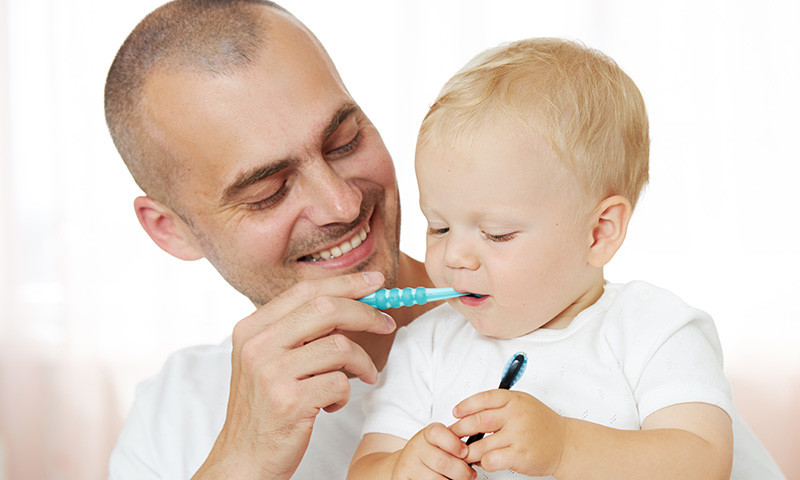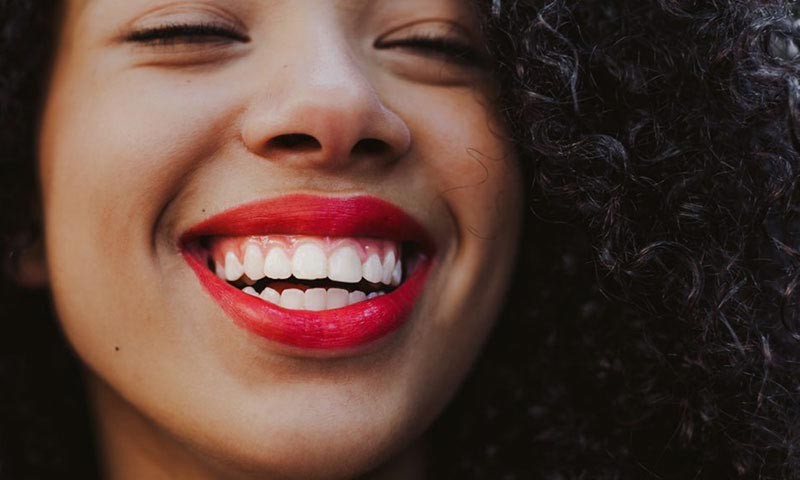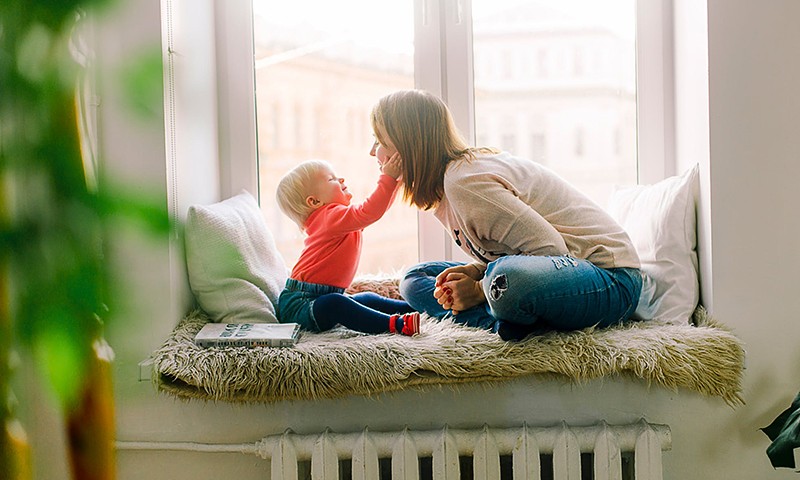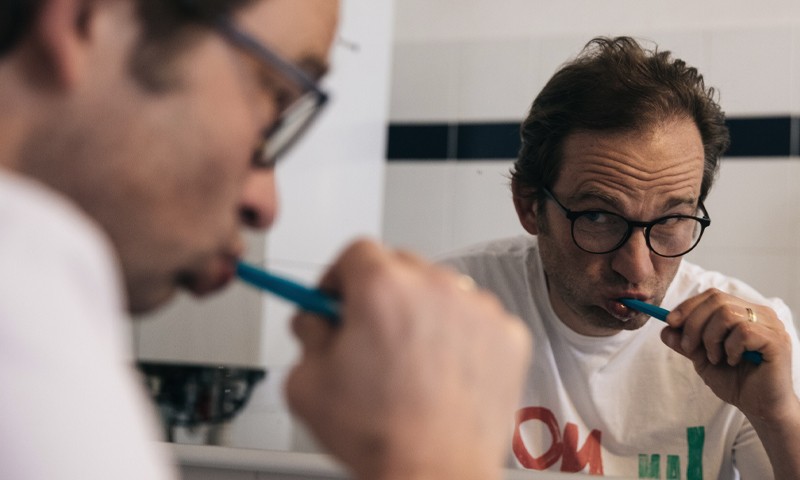Dental care for babies – protection against dental caries from the start
"Milk teeth are going to fall out anyway." – That is what a lot of parents think and therefore fail to care for their baby's teeth properly. A terrible mistake, as new milk teeth are particularly susceptible to dental caries. The enamel is only about half as thick as that on adult teeth. And bacteria can, therefore, colonise and swiftly penetrate the interior of the tooth.
However, your baby needs healthy teeth – and not just for biting, chewing and learning to talk. The milk teeth actually act as guides for their permanent teeth. If a milk tooth is exposed to dental caries and has to be extracted, the permanent tooth is unable to grow properly and irregularities occur.
Regrettably, children are not simply given a complete set of healthy permanent teeth when losing their first ones: Decayed milk teeth can infect and damage permanent teeth before they even erupt. Conversely: If you brush their teeth regularly and correctly from the start, there is a good chance of your baby enjoying healthy teeth for years to come. Brushing your baby's teeth is not only important, it is essential.
Good to know:
Did you know that cavity-causing bacteria can be transmitted through saliva? So, if you place a dummy, drinking bottle or spoon in your mouth before giving it to your baby, there is a risk of transmitting cavity-causing bacteria to your baby's teeth. Therefore, take very good care of your teeth and always think twice before licking a spoon and giving it to your baby.
When should you start brushing your baby's teeth?
Start brushing your baby's teeth as soon as the first milk tooth breaks through, usually at around six or seven months. Remember, cavity-causing bacteria do not wait until all their milk teeth have erupted before launching an attack and are quite happy to damage them one by one if you allow it.
Interesting fact: The incisors are the first teeth to emerge and the molars are usually the last to develop. Your child normally has a full set of 20 milk teeth after roughly 20 months.
Want to get your baby used to brushing their teeth? Then, start wiping their gums and tongue with a flannel even before their first teeth erupt. They will soon become completely familiar with this daily dental hygiene routine.
Good to know:
The arrival of a baby's first teeth is an exciting and memorable milestone for parents, but generally a painful and difficult process for babies. Chewing on a teething ring is a great way to counter the pressure and ease the pain of teething. Besides being free of harmful substances, our model also offers a lot of entertainment: An integrated rattle, colourful balls and a learning toothbrush that playfully prepares your baby for the day when they start brushing their teeth.
At what age can a baby start using toothpaste?
The European Academy of Paediatric Dentistry (EAPD) recommends using fluoride toothpaste to brush your baby's teeth twice a day as soon as their first tooth comes through. Continue using a rice grain-sized amount of toothpaste until they are about two years old. Progress to a pea-sized amount at age two.
At what age can a baby spit out toothpaste?
A baby is not able to spit out toothpaste. This is something that children do not learn to do until they are two or three years old. It is therefore important not to use too much toothpaste when brushing your baby's teeth and to always follow the EAPD's recommendations.
Rinsing their mouth after brushing is also not necessary. We also advise adults and older children just to spit out the toothpaste and not to rinse their mouth with water after brushing. This allows the fluoride to develop its full effect. You might be asking yourself: "How is my baby supposed to spit out toothpaste?" Not at all. Since the amount of toothpaste on the brush is so tiny, your baby does not have to spit it out after brushing.
Many parents are worried about their baby swallowing fluoride toothpaste when brushing their teeth and being poisoned. But there really is nothing to worry about. The German Federal Institute for Risk Assessment (BfR) determined that your baby may have an upset tummy at worst after consuming a whole tube of toothpaste.
Which toothpaste is suitable for your baby?
With lots of toothpaste options available, many parents become overwhelmed when it comes to choosing the right one for their baby. Much of the information found online is confusing and contradictory. The best thing you can do is to follow the EAPD's recommendations: Brush your baby's first milk teeth using a toothpaste with a fluoride concentration of up to 1,000 parts per million (ppm). The fluoride helps strengthen the enamel of your baby's teeth, thereby offering effective protection against dental decay.
Nevertheless, if you are concerned about your baby consuming too much fluoride, as they are also eating baby food prepared with fluoridated tap water, or do not want to use flouride at all, you can opt for a zero fluoride kids toothpaste.
For a long time, scientists debated the question of whether it is better to provide fluoride through toothpastes or tablets. Today, we know that fluoride toothpastes are more effective due to their direct contact with the surface of the tooth.
Important: If you use a fluoride toothpaste, do not not give your baby any fluoride tablets. An overdose can lead to your child suffering a condition called dental fluorosis and developing white lines or flecking on the surface of their teeth.
Good to know:
Do not be confused by the age details on the packs of Curaprox kids toothpastes. They are based on age recommendations provided by the EAPD. According to the latest research, you can brush your baby's teeth using a toothpaste with a fluoride concentration of up to 1,000 parts per million (ppm).
How do you brush your baby's teeth?
The toothpaste question has been answered. But how do you actually brush your baby's teeth? Which technique is the right choice? How often should parents brush their baby's teeth? And for how long? Find all the answers you need here.
What should I use to brush my baby's teeth?
To ensure optimal brushing of your baby's first teeth, use a super-soft baby toothbrush with a small head and a large handle. This allows for an easy grip and good manoeuvrability when brushing. Finger toothbrushes – a small rubberised brush with little bumps and bristles that slips over your finger – are also available but do not clean teeth thoroughly. Cotton buds also fail to remove plaque effectively.
When buying a baby toothbrush, always make sure it is free of harmful substances. Especially when going through the oral phase, your baby puts everything in their mouth and will certainly derive immense pleasure from chewing on a toothbrush.
Insider tip: It is a good idea to buy two baby toothbrushes. One for brushing your baby's teeth correctly and one for them to play with as a distraction. Your baby will be enthralled! After all, few things can match the excitement of a toy that is not actually a toy.
Good to know:
The Curaprox baby toothbrushes are recommended by dentists around the world. These brushes are equipped with 4,260 super-soft Curen® filaments that clean your baby's first teeth both gently and thoroughly. The soft rubberised brush head protects the delicate oral mucosa. Particularly important: Since the entire toothbrush is free of harmful substances, your baby can chew on it to their heart's content. Brushing a baby's teeth has never been so much fun and this safe before.
How long should you brush your baby's teeth?
Once their first molars have emerged, you should brush your baby's teeth for roughly two minutes. One minute is enough if only their incisors are visible.
How often should you brush your baby's teeth?
The same rule applies to babies and adults: Teeth need to be brushed twice a day – in the morning and in the evening.
When should you brush your baby's teeth?
Brush your baby's teeth in the morning after breakfast and at night before going to bed. But remember to wait at least 30 minutes after eating to allow the saliva to neutralise the acids in their mouth.
It is best to make tooth brushing a regular part of your baby's daily routine – for example, right after changing their nappy and getting them changed. This helps them become familiar with a daily dental hygiene routine. Incorporating toothbrushing into your evening routine can also act as a soothing transition into the cosy part of your day: For example, you can sing them a toothbrushing lullaby when brushing their teeth before cuddling up in bed, where a bedtime story awaits.
What is the correct technique for brushing your baby's teeth?
Position the baby toothbrush at a 45-degree angle where the teeth meet the gums – hold the brush at an upward sloping angle in the upper jaw and at a downward sloping angle in the lower jaw. Brush each tooth individually along a row of teeth using gentle and small circular movements. This applies to the inner and outer surfaces as well as the chewing surfaces. Pay special attention to the back molars. They are difficult to reach, but if you hold the brush vertically, cleaning them correctly should not be a problem. It takes roughly two minutes to brush your baby's teeth this way.
How should I hold my baby when brushing their teeth?
When it comes to achieving the right position for brushing your baby's teeth, two things are important: A relaxed position for your baby and a good view of their oral cavity. Here are a few tips that have proven to be effective:
Brushing teeth in front of a mirror
Sit on a stool in front of a large mirror and put your baby on your lap with their back to your chest. This allows you both to see what is happening.
Brushing teeth on a changing table
The changing table is a familiar environment for your baby and a great place to brush their teeth. Slightly raise your baby's head when brushing their teeth. This provides you with a good view of their oral cavity.
Brushing teeth in a baby bouncer
Place your baby in the baby bouncer and sit on the floor with them. This ensures you are both at eye level with each other and you have a good view of their mouth.
Brushing teeth in the crook of your arm
Similar to when breastfeeding, hold your baby in the crook of your arm and brush their teeth in this position. Disadvantage: You only have one hand free.
Brushing your baby's teeth for the first time: How to do it
When brushing your baby's teeth for the first time: Take your time and be relaxed while you are doing it. The primary focus here is getting your baby used to brushing their teeth while ensuring the overall experience remains as positive as possible. And it is not the end of the world if your brushing technique is not up to scratch just yet. The most important thing is that your baby becomes completely familiar with this new daily routine.
Here are a few tips to help get you started:
- Use a teething ring with a massage toothbrush to prepare your baby for the first toothbrushing experience. This gets them used to the sensation of having a brush in their mouth.
- Give your baby their own baby toothbrush to mark the special occasion. While they are examining this new and unfamiliar object, you can carefully insert a second baby toothbrush into their mouth and gently brush the new tooth using gentle, circular movements.
- Do not use any toothpaste the first time. Initially, the presence of the new foreign object in their mouth and the sensation of the toothbrush against the tooth create enough novel sensory experiences. Introduce toothpaste as soon as your child has become used to the toothbrush – but remember a rice grain-sized amount is sufficient at first.
- Praise and encourage your baby when they attempt to put their own toothbrush in their mouth. This is a great stride towards accepting the toothbrush as a familiar object. They are now going to be gnawing and chewing on things a lot. This is completely normal and also the reason why you should give yourself plenty of time at the beginning.
- Just make sure that brushing your baby's first tooth is as pleasant and enjoyable as it can possibly be. Singing, cuddly toys, stories – anything goes. Never force the toothbrush into their mouth at first. This could potentially make your baby afraid of brushing their teeth and turn their daily dental hygiene routine into an unpleasant ordeal.
Brushing teeth from age two
Once your child turns two, you can start encouraging them to brush their own teeth – also in the morning after breakfast and at night before going to bed. Very important: Your child is usually ready to brush their teeth unsupervised when they are able to do joined-up handwriting with ease – so not until the age of seven to nine. This is why you should follow up at least once a day, preferably twice, until they reach this stage.
My baby does not let me brush their teeth – what should I do?
Many parents complain about the daily battles with their 10 to 13-month-old baby who simply hates having their teeth brushed. But what can you do as a parent? First make sure that you are not hurting your baby when brushing their teeth. Many new parents are unaware of the problems that the frenulum can cause babies and small children. Parents often unwittingly catch the frenulum when brushing their baby's teeth, something that can be very painful for a child. To avoid this dilemma, slightly raise the upper lip to see exactly where the frenulum is located. Further, brush all your baby's teeth extremely carefully and with very little pressure.
Seven tips if your baby hates brushing their teeth
Once you have made sure that you are not accidentally hurting your baby, the following tips help to make brushing more fun for both of you. It is important to know: Your baby or toddler does not yet realise how essential regular brushing really is. Therefore, it is up to you as the parent to ensure that their teeth are being brushed correctly at least twice a day.
You are responsible for nurturing your child with a daily oral hygiene routine. Giving up, frustrated and disappointed, just because your 10-month-old baby will not let you brush their teeth is a very bad idea and will put them at higher risk of dental problems down the line.
Good to know:
It takes humans roughly three weeks to get used to a new routine. And this also applies to your baby and brushing their teeth. Please do not give up, even if things do not go as you wish. Your baby will eventually get used to brushing their teeth and it will become easier.
1. Songs for brushing your baby's teeth
Babies love songs and are usually more relaxed when hearing the sound of a voice singing – also when brushing their teeth. And, needless to say, it is much more enjoyable when their mummy and daddy sing to them.
If you do not fancy singing yourself, you can, of course, always play a song to your baby. There are plenty of dental-themed songs and rhymes on various streaming services.
2. Show your baby how to brush teeth correctly
Quite often small children are unaware that their mummy and daddy also brush their teeth, as they tend to get up earlier and go to bed later. But when your baby sees that you also brush your teeth, they may want to do it, too.
3. Let your baby have a go at brushing your teeth
This toothbrushing technique might not be the most effective one but is super cute to say the least: When both parents are present, your baby can brush the teeth of one parent while the other one brushes your baby's teeth. Brushing a baby's or toddler's teeth frequently comes down to teamwork.
4. Teddy also needs to brush its teeth
Take your baby's favourite cuddly toy and show your baby that it also needs to have its teeth brushed. Place the cuddly toy in front of a mirror, adopt a different voice and explain to your baby how important it is to brush their teeth. This method works surprisingly well if your child is still young enough to believe that the cuddly toy is actually talking to them.
5. Tell exciting tales
Even if your baby is not yet able to fully comprehend the link between dental caries, acids and damaged tooth enamel, they will surely enjoy listening to a fascinating tale. Especially if the main characters are a toothbrush, toothpaste and some nasty bacteria.
6. Let your baby play with the toothbrush
Tell the truth: Would you feel comfortable if someone inserted an unfamiliar object into your mouth and started poking around with it? Most probably not. Keep in mind that initially, a toothbrush is an unfamiliar foreign object for your baby. Give them time to get used to it and allow them to explore their new toothbrush with all their senses. As mentioned above, you can always use two brushes: One for brushing and one for picking up and exploring.
7. Stay calm and relaxed yet assertive
This is probably easier said than done, but it really is extremely important. Babies are sensitive to non-verbal signals and can sense when you are stressed or relaxed. If you refuse to get flustered and clearly show your baby that their daily dental hygiene routine is going to happen no matter what, they will, sooner or later, accept toothbrushing as part of their daily routine. Further: All the battles and tantrums around brushing teeth are most likely just a phase. And the difficult times of getting your child to brush their teeth, which can sometimes require a great deal of persuasion, eventually come to an end.
Good to know:
You do not have to be too assertive the very first time you brush your baby's teeth. If you realise your baby is not going to cooperate no matter what you do, maybe it is just not the right day. To ensure this initial toothbrushing experience does not end in tears, simply try again the next day.
When should I take my baby to the dentist for the first time?
We recommend arranging an appointment for your baby to see a dentist either after their first tooth has emerged or around their first birthday. This gives your dentist the chance to see if everything is okay and your baby can get used to visiting a dentist early on. You should start taking your baby for routine check-ups once a year thereafter. Important: Avoid scaring your baby. Going to see a dentist is just like shopping in a supermarket or visiting relatives; it is a completely normal thing to do and there is nothing to fear.
Summary: Everything you need to know about brushing your baby's teeth correctly
We have summarised the most important points for you below:
- Start brushing your baby's teeth as soon as the first milk tooth breaks through, usually at around six months.
- Use a special baby toothbrush with super-soft filaments and a small head as well as a rice grain-sized amount of toothpaste.
- Make sure the toothpaste has a fluoride concentration of up to 1,000 parts per million (ppm). If you give your baby fluoride tablets, choose a zero fluoride children's toothpaste.
- Brush your baby's teeth daily in the morning after breakfast and at night before going to bed for two minutes each time. Make sure that tooth brushing becomes a regular part of your baby's daily routine.
- Arrange to see a dentist either after your baby's first tooth has emerged or around their first birthday.
- Remember to make brushing your baby's teeth as relaxed and as pleasant as possible. Having fun and a positive experience are always more important than using the perfect toothbrushing technique.
In this spirit: Enjoy brushing your baby's teeth!
Sources
Andrae, Christian: Richtig Zähne putzen – von Anfang an, at: apotheken-umschau.de.
Berg, Bettina et al.: Kariesprävention im Säuglings- und frühen Kindesalter, in Monatsschrift Kinderheilkunde. 2021.
Bok, Hye-Jeong et al.: Proper Tooth-Brushing Technique According to Patient’s Age and Oral Status, in: International Journal of Clinical Preventive Dentistry. 2020.
German Federal Institute for Risk Assessment (BfR): Risiko Vergiftungsunfälle bei Kindern.
German Dental Association: Kinder.
German Dental Association: Hinweise für Eltern.
German Federal Centre for Health Education: Gesunde Zähne von Anfang an, at: kindergesundheit-info.de.
German Federal Centre for Health Education: Zähneputzen mit KAI – kinderleicht, at: kindergesundheit-info.de.
Kinder- & Jugendärzte im Netz: Welche Zahnbürste ist optimal für mein Kind?.
Kinder- & Jugendärzte im Netz: Wie oft sollen die Zähne geputzt werden und welche Zahnpasta ist geeignet?.
Netzwerk Gesund ins Leben: Zähne ab der Geburt schützen.
Robert Koch Institute: Mundhygiene und Kariesprophylaxe.
Schulters, Julia Maria: Karies in den Milchzähnen ist gefährlich, at: apotheken-umschau.de.
Toumba, K.J. et al.: Guidelines on the use of fuoride for caries prevention in children: an updated EAPD policy document, in: European Archives of Paediatric Dentistry. 2019.
 Swiss premium oral care
Swiss premium oral care









